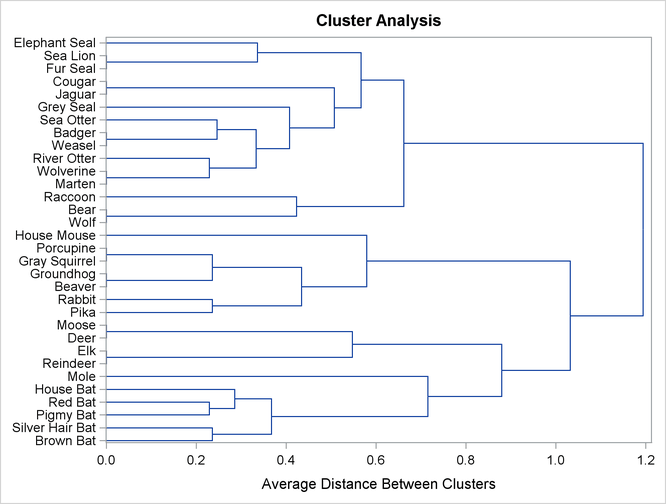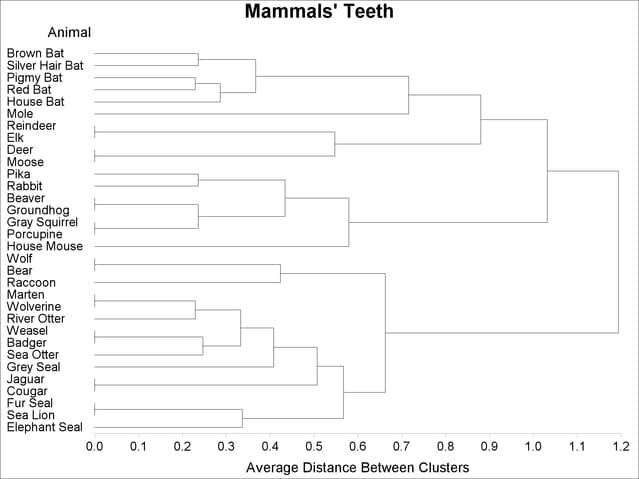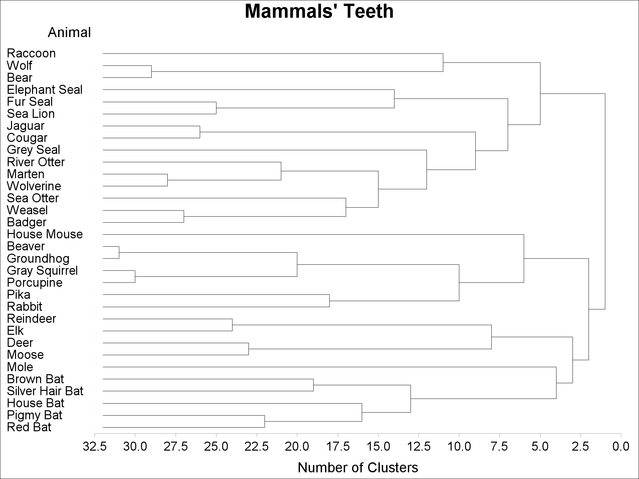The TREE Procedure
Example 118.1 Mammals’ Teeth
The following statements produce a data set that contains the numbers of different kinds of teeth for a variety of mammals:
data teeth;
title 'Mammals'' Teeth';
input mammal & $16. v1-v8 @@;
label v1='Right Top Incisors'
v2='Right Bottom Incisors'
v3='Right Top Canines'
v4='Right Bottom Canines'
v5='Right Top Premolars'
v6='Right Bottom Premolars'
v7='Right Top Molars'
v8='Right Bottom Molars';
datalines;
Brown Bat 2 3 1 1 3 3 3 3 Mole 3 2 1 0 3 3 3 3
Silver Hair Bat 2 3 1 1 2 3 3 3 Pigmy Bat 2 3 1 1 2 2 3 3
House Bat 2 3 1 1 1 2 3 3 Red Bat 1 3 1 1 2 2 3 3
Pika 2 1 0 0 2 2 3 3 Rabbit 2 1 0 0 3 2 3 3
Beaver 1 1 0 0 2 1 3 3 Groundhog 1 1 0 0 2 1 3 3
Gray Squirrel 1 1 0 0 1 1 3 3 House Mouse 1 1 0 0 0 0 3 3
Porcupine 1 1 0 0 1 1 3 3 Wolf 3 3 1 1 4 4 2 3
Bear 3 3 1 1 4 4 2 3 Raccoon 3 3 1 1 4 4 3 2
Marten 3 3 1 1 4 4 1 2 Weasel 3 3 1 1 3 3 1 2
Wolverine 3 3 1 1 4 4 1 2 Badger 3 3 1 1 3 3 1 2
River Otter 3 3 1 1 4 3 1 2 Sea Otter 3 2 1 1 3 3 1 2
Jaguar 3 3 1 1 3 2 1 1 Cougar 3 3 1 1 3 2 1 1
Fur Seal 3 2 1 1 4 4 1 1 Sea Lion 3 2 1 1 4 4 1 1
Grey Seal 3 2 1 1 3 3 2 2 Elephant Seal 2 1 1 1 4 4 1 1
Reindeer 0 4 1 0 3 3 3 3 Elk 0 4 1 0 3 3 3 3
Deer 0 4 0 0 3 3 3 3 Moose 0 4 0 0 3 3 3 3
;
The following statements use the CLUSTER procedure to cluster the mammals by average linkage and use ODS Graphics and the TREE procedure to produce a horizontal tree diagram that uses the average-linkage distance as its height axis:
ods graphics on; proc cluster method=average std pseudo noeigen outtree=tree; id mammal; var v1-v8; run;
proc tree horizontal; label _name_ = 'Animal'; run;
Output 118.1.1 displays the information about how the clusters are joined. For example, the cluster history shows that the mammals 'Wolf' and 'Bear' form cluster 29, which is merged with 'Raccoon' to form cluster 11.
Output 118.1.1: Output from PROC CLUSTER
| Cluster History | |||||||
|---|---|---|---|---|---|---|---|
| Number of Clusters |
Clusters Joined | Freq | Pseudo F Statistic |
Pseudo t-Squared |
Norm RMS Distance |
Tie | |
| 31 | Beaver | Groundhog | 2 | . | . | 0 | T |
| 30 | Gray Squirrel | Porcupine | 2 | . | . | 0 | T |
| 29 | Wolf | Bear | 2 | . | . | 0 | T |
| 28 | Marten | Wolverine | 2 | . | . | 0 | T |
| 27 | Weasel | Badger | 2 | . | . | 0 | T |
| 26 | Jaguar | Cougar | 2 | . | . | 0 | T |
| 25 | Fur Seal | Sea Lion | 2 | . | . | 0 | T |
| 24 | Reindeer | Elk | 2 | . | . | 0 | T |
| 23 | Deer | Moose | 2 | . | . | 0 | |
| 22 | Pigmy Bat | Red Bat | 2 | 281 | . | 0.2289 | |
| 21 | CL28 | River Otter | 3 | 139 | . | 0.2292 | |
| 20 | CL31 | CL30 | 4 | 83.2 | . | 0.2357 | T |
| 19 | Brown Bat | Silver Hair Bat | 2 | 76.7 | . | 0.2357 | T |
| 18 | Pika | Rabbit | 2 | 73.2 | . | 0.2357 | |
| 17 | CL27 | Sea Otter | 3 | 67.4 | . | 0.2462 | |
| 16 | CL22 | House Bat | 3 | 62.9 | 1.7 | 0.2859 | |
| 15 | CL21 | CL17 | 6 | 47.4 | 6.8 | 0.3328 | |
| 14 | CL25 | Elephant Seal | 3 | 45.0 | . | 0.3362 | |
| 13 | CL19 | CL16 | 5 | 40.8 | 3.5 | 0.3672 | |
| 12 | CL15 | Grey Seal | 7 | 38.9 | 2.8 | 0.4078 | |
| 11 | CL29 | Raccoon | 3 | 38.0 | . | 0.423 | |
| 10 | CL18 | CL20 | 6 | 34.5 | 10.3 | 0.4339 | |
| 9 | CL12 | CL26 | 9 | 30.0 | 7.3 | 0.5071 | |
| 8 | CL24 | CL23 | 4 | 28.7 | . | 0.5473 | |
| 7 | CL9 | CL14 | 12 | 25.7 | 7.0 | 0.5668 | |
| 6 | CL10 | House Mouse | 7 | 28.3 | 4.1 | 0.5792 | |
| 5 | CL11 | CL7 | 15 | 26.8 | 6.9 | 0.6621 | |
| 4 | CL13 | Mole | 6 | 31.9 | 7.2 | 0.7156 | |
| 3 | CL4 | CL8 | 10 | 31.0 | 12.7 | 0.8799 | |
| 2 | CL3 | CL6 | 17 | 27.8 | 16.1 | 1.0316 | |
| 1 | CL2 | CL5 | 32 | . | 27.8 | 1.1938 | |
Output 118.1.2 shows the tree diagram produced by PROC CLUSTER.
Output 118.1.2: Dendrogram from PROC CLUSTER

Output 118.1.3 shows the corresponding tree diagram produced by PROC TREE.
Output 118.1.3: Tree Diagram of Mammal Teeth Clusters

As you view the diagram in Output 118.1.3 from left to right, objects and clusters are progressively joined until a single, all-encompassing cluster is formed at the right (or root) of the tree. Clusters exist at each level of the diagram, and every vertical line connects leaves and branches into progressively larger clusters. For example, the five bats form a cluster at the 0.6 level, while the next cluster consists only of the mole. The mammals 'Reindeer', 'Elk', 'Deer', and 'Moose' form the next cluster at the 0.6 level, the mammals 'Pika' through 'House Mouse' are in the fourth cluster, the mammals 'Wolf', 'Bear', and 'Raccoon' form the fifth cluster, and the last cluster contains the mammals 'Marten' through 'Elephant Seal'.
The following statements create the same tree with line printer graphics in a vertical orientation:
options ps=40; proc tree lineprinter; run;
The line printer plot is not displayed.
The next statements sort the clusters at each branch in order of formation and use the number of clusters as the height axis:
proc tree sort height=n horizontal; label _name_ = 'Animal'; run;
The resulting tree is displayed in Output 118.1.4.
Output 118.1.4: PROC TREE with SORT and HEIGHT= Options

Because the CLUSTER procedure always produces binary trees, the number of internal (root and branch) nodes in the tree is one less than the number of leaves. Therefore 31 clusters are formed from the 32 mammals in the input data set. These are represented by the 31 vertical line segments in the tree diagram, each at a different value along the horizontal axis.
As you examine the tree from left to right, the first vertical line segment is where 'Beaver' and 'Groundhog' are clustered and the number of clusters is 31. The next cluster is formed from 'Gray Squirrel' and 'Porcupine'. The third contains 'Wolf' and 'Bear'. Note how the tree graphically displays the clustering order information that was presented in tabular form by the CLUSTER procedure in Output 118.1.1.
The same clusters as in Output 118.1.3 can be seen at the six-cluster level of the tree diagram in Output 118.1.4, although the SORT and HEIGHT= options make them appear in a different order.
The following statements create these six clusters and save the result in the output data set part:
proc tree noprint out=part nclusters=6; id mammal; copy v1-v8; run; proc sort; by cluster; run;
PROC TREE with the NOPRINT option displays no output but creates an output data set that indicates the cluster to which each
observation belongs at the six-cluster level in the tree. The following statements print the data set part, with the results shown in Output 118.1.5:
proc print label uniform; id mammal; var v1-v8; format v1-v8 1.; by cluster; run;
Output 118.1.5: PROC TREE OUT= Data Set
| Mammals' Teeth |
| mammal | Right Top Incisors |
Right Bottom Incisors |
Right Top Canines |
Right Bottom Canines |
Right Top Premolars |
Right Bottom Premolars |
Right Top Molars |
Right Bottom Molars |
|---|---|---|---|---|---|---|---|---|
| Beaver | 1 | 1 | 0 | 0 | 2 | 1 | 3 | 3 |
| Groundhog | 1 | 1 | 0 | 0 | 2 | 1 | 3 | 3 |
| Gray Squirrel | 1 | 1 | 0 | 0 | 1 | 1 | 3 | 3 |
| Porcupine | 1 | 1 | 0 | 0 | 1 | 1 | 3 | 3 |
| Pika | 2 | 1 | 0 | 0 | 2 | 2 | 3 | 3 |
| Rabbit | 2 | 1 | 0 | 0 | 3 | 2 | 3 | 3 |
| House Mouse | 1 | 1 | 0 | 0 | 0 | 0 | 3 | 3 |
| mammal | Right Top Incisors |
Right Bottom Incisors |
Right Top Canines |
Right Bottom Canines |
Right Top Premolars |
Right Bottom Premolars |
Right Top Molars |
Right Bottom Molars |
|---|---|---|---|---|---|---|---|---|
| Marten | 3 | 3 | 1 | 1 | 4 | 4 | 1 | 2 |
| Wolverine | 3 | 3 | 1 | 1 | 4 | 4 | 1 | 2 |
| Weasel | 3 | 3 | 1 | 1 | 3 | 3 | 1 | 2 |
| Badger | 3 | 3 | 1 | 1 | 3 | 3 | 1 | 2 |
| Jaguar | 3 | 3 | 1 | 1 | 3 | 2 | 1 | 1 |
| Cougar | 3 | 3 | 1 | 1 | 3 | 2 | 1 | 1 |
| Fur Seal | 3 | 2 | 1 | 1 | 4 | 4 | 1 | 1 |
| Sea Lion | 3 | 2 | 1 | 1 | 4 | 4 | 1 | 1 |
| River Otter | 3 | 3 | 1 | 1 | 4 | 3 | 1 | 2 |
| Sea Otter | 3 | 2 | 1 | 1 | 3 | 3 | 1 | 2 |
| Elephant Seal | 2 | 1 | 1 | 1 | 4 | 4 | 1 | 1 |
| Grey Seal | 3 | 2 | 1 | 1 | 3 | 3 | 2 | 2 |
